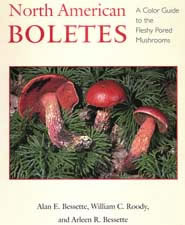

The boletes comprise a major part of the mycota everywhere on Earth that ectomycorrhizal trees such as pines, firs, spruces, hemlocks, oaks, beech, and birch, grow. Given the predominance of these trees in most North American forests, it’s not surprising that boletes often find their way into NAMA members’ baskets, as well as onto their dinner plates. Until now, there has been no comprehensive well-illustrated guide to the boletes of our continent. To identify our collections we have had to rely on: (1) monographic treatments (for just certain genera or for just certain geographic areas) written in technical jargon and containing, at best, laboratory-staged black and white photographs of varying quality; or (2) field guides, usually with good quality color illustrations, but typically dealing with only a tiny percentage of the total bolete taxa, and often with the same set of widespread species appearing from book to book. This beautiful new book by three well-known NAMA members will make it possible for North American mushroomers to identify far more than Boletus edulis, Suillus luteus, and Tylopilus felleus.
The introductory material is refreshingly brief. The authors wisely don’t repeat all of the same old stuff that we already have in too many of the field guides on our shelves. There’s an interesting synopsis of North American “boletology,” an introduction to boletes and their characteristic morphology, and instructions on how to make best use of the book to identify boletes. This is followed by a set of “field” keys (although I don’t imagine many users will be lugging this book into the field, both because of its 4-pound weight and for fear of marring it). These keys utilize macroscopic and ecologic information and allow the user to narrow his/her search to a single species or a group of similar-looking species. In the latter case, each species is listed with a brief description that can be used to separate it from its look-alikes. One reviewer has criticized this approach, suggesting that continuing the dichotomous keys would have been more helpful by relieving the user from reading through and comparing several descriptions simultaneously. I don’t agree. Arriving at a name at the end of any keying process is only a starting point. Confirmation of a tentative identification always requires careful comparison of the specimens with one or more descriptions anyway, so extending the keys in this case would only have introduced a false sense of certainty. The keys (58 pages-worth) are separated first by eastern and western regions (divided by the Rocky Mountains) and then by stipe characteristics and pore surface color. In my initial trials with actual collections, they were easy to use and led me to accurate identifications.
The bulk of the volume is devoted, as it should be, to the descriptions and illustrations, to which I’ll return in a moment. Completing the book are three appendixes dealing with the use of chemical reagents for identifying boletes, microscopic examination of boletes, and collecting, cooking, and preserving them; a glossary; list of references; separate indexes to common and scientific names; and a list of photo credits.
According to the dust jacket, over 300 species are described and, according to Harley the mushroom-book statistician Barnhart, all but 11 of them are illustrated with superb color photographs. Each description includes the fungus name (with author and publication reference); macroscopic characteristics of pileus, pore surface, and stipe; spore print color; summary of macrochemical reactions; microscopic features (typically spore size, shape, and ornamentation); fruiting habit, habitat, range, and season; edibility; and miscellaneous comments. The descriptions are organized alphabetically; first by genus, then species. Each occupies about half of an 8 x 10” page. The photographs are grouped separately from the descriptions and also are arranged alphabetically. Typically six 2 x 3” photos are presented on each page, with an occasional larger vertically oriented shot reducing the total to five. The quality of the photos is absolutely top-notch and the authors must be commended for going to the trouble (and considerable expense) of soliciting approximately 200 slides from 38 photographers to augment their own large libraries of photos. Altogether, over 450 images are included, with many species being shown in multiple shots to illustrate the range of variation within the taxon. In addition to the photos in the description section, some particularly striking ones are used for divider pages and as accents throughout the book—a nice touch.
In addition to named bolete species, an assortment of pseudoboletes and bolete collections that could not easily be assigned to a described species are included and illustrated. I suspect that most users will find the former to be more helpful than the latter.
My complaints are few. The main one is that the text margins are wider than they need to be—I’d rather see the unused space devoted to lengthier comments sections, as some did not adequately address what I would consider to be the more likely “look-alikes.” There are a few typos but, overall, the book is extremely attractive and well produced. It ain’t cheap, but nowadays few things are, especially good mushroom books. The satisfaction you’ll feel each time you identify a species that you never would have before should more than make up for the dent in your bank account. Buy this book.
Review by Steve Trudell, Seattle / Originally published in The Mycophile 42:2, 2001
****************************************************************
simply close this document to return to the Cumberland Mycological Society web site
to return to previous menu